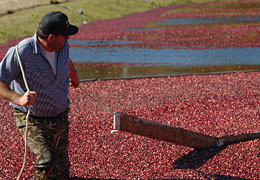Sauced and Juiced

If you drive along the coast in Coos and Curry counties in October, you'll see a harvest unlike any other. In cranberry season, flooded fields look like beds covered with bumpy, burgundy-colored chenille.
Cranberry growers flood their fields with water at harvest time to raise the lowgrowing vines from their sandy beds. Machines like giant eggbeaters churn the water and knock the fruit off the vines as small pockets of air inside the berries float them to the top. Farmers in chest waders slosh through the water, marshaling masses of cranberries with booms and long-handled rakes. Trucks waiting at the shore take the berries to be sold fresh or made into juice or sauce. Harvest lasts until shortly before Thanksgiving. Good timing.
Such colorful harvests are part of a year-round cycle for cranberry growers such as Knute Andersson, who has been growing cranberries in Coos County for more than 20 years. "In cranberry country, there's always something new to deal with— new bugs, new diseases, new ways to manage pests," said Andersson.

- Jim Bussmann harvests cranberries in his family's fields near Bandon. Photo by Lynn Ketchum.
One thing they have to deal with is frost. Cranberry growers in Oregon sleep uneasily from March to May, when clear and windless nights bring the threat of killing frosts. Growers watch and wait, then turn on sprinklers at just the right time and temperature so ice forms quickly into a protective coat that preserves latent heat in the fragile cranberry buds. If their timing is off or if the ambient temperature changes, the entire crop can be lost in less than an hour.
So, growers wanted a way to take the guesswork out of frost control. One possible solution is being tested by Oregon State University. Linda White, a horticulture professor in the Coos County office of OSU Extension, shows off a field of about 20 "frost units," small metal boxes filled with sensors. They look like refrigerators made for Hobbits. The units are set at varying temperatures and placed over vines and berries,
then checked daily as part of a three-year study funded by the Northwest Center for Small Fruits Research.

- OSU horticulture researcher Luis Valenzuela studies cranberry root systems. Photo by Lynn Ketchum.
"After we examine the cranberry vines and buds for damage from the frost units," White said, "we will know what temperatures and at what bud stages irrigation is needed to protect against damage from frost."
"We've wanted this research for many years," Andersson said, adding that it will provide a more realistic approach to take measurements in the field. "And, when we find out exactly how much cold the berries can take, we'll save electricity, water, and time," he said.
Native to North America, cranberries were first planted in Oregon in 1885. Now the state ranks fourth in the nation's cranberry production, behind states with colder winters and more predictable frost events. With proper care, cranberry vines can live up to 100 years.
Oregon growers apply large amounts of calcium to keep their cranberry plants healthy and to counter possible adverse effects from a particular herbicide that can stress vines and delay root growth. OSU researchers study cranberry root systems using specially made cameras, called minirhizotrons. The cameras are lowered down long, narrow plastic tubes stuck into the ground. "The system allows us to look at roots at varying depths and through time so we can monitor their movement, growth, and development," White said.

- With a powered, walk-behind rake, grower Richard "Mooch" Roberts dry-harvests cranberries and sacks them in burlap bags. Photo by Lynn Ketchum.
Most people know cranberries for their traditional saucy place on Thanksgiving dinner tables and the sweetened, dried berries that are popular snacks. But cranberry juice is the marketplace star, supported by human health studies that reveal its particular "Teflon" qualities, according to the Cranberry Marketing Committee.
Cranberry juice can help maintain urinary tract health, according to studies by the National Institutes of Health. The juice contains compounds known as proanthocyanidins, healthy plant flavonoids that are also found in red wine, apples, and green tea. But unlike those other foods, cranberry proanthocyanidins contain components that prevent harmful bacteria from binding to cells that line the bladder wall. Studies suggest that this anti-adhesion activity gives cranberry juice an edge over bacterial infections.
There's much to celebrate with cranberries. Since 1946, the coastal community of Bandon has painted the town red each September at its Cranberry Festival, showcasing the little berry's $10 million contribution to the state economy. OSU research and Extension are strong partners in keeping Oregon cranberries floating to the top.

